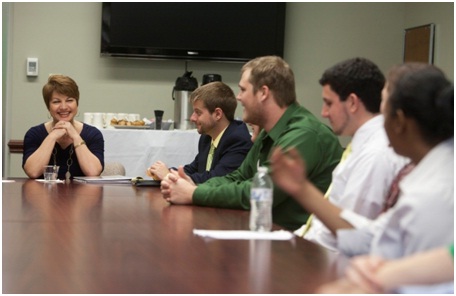Published on
Performance Measurement Changes to Heighten Focus on Non-Traditional Students

As the new president of a multi-university higher education system, the first thing I set out to do was to visit each campus and to meet the leaders and stakeholders. Nine different times, I sat in a room with student leaders who were impressively engaged, driven, enthusiastic and mostly … young. By young I mean that, on average, they were 21 years old and about to graduate from college.
While I was blown away by their maturity and ambitions, I could not help but think that, as a nontraditional college student, I would have never been in such a room meeting the new university president; I would have been hurrying to the store to buy diapers, or reporting for my second job while juggling school, work and family. While the younger students enrolled in college and started engaging in campus leadership activities right out of high school, I got married and started a family at 18. It took me 10 years to earn a college degree, taking mostly night and weekend classes.
My story is not unique. Thirty percent of the more than 92,000 students in the University of Louisiana System (UL System) are aged 25 or older, but that is not the determining factor for a non-traditional student. According to the National Center for Education Statistics, for students to be considered non-traditional, they must meet at least one of the following descriptions:
- Delayed enrollment in postsecondary education
- Part-time attendance
- Financially independent
- Working full-time while enrolled
- Has dependents other than a spouse
- Is a single parent
- Has not obtained a standard high school diploma
Yes indeed, I definitely fit that description.
Nationally, non-traditional students are becoming the new norm, especially with a growing population of military veterans. That is not to minimize the importance of traditional students and the valuable quest to decrease the time it takes for every student to earn a degree. Traditional students will likely always be the core base of higher education enrollment, but colleges and universities also need to carve out programs and services to meet the needs of their older populations.
When I was in college, the only special program available to me was a federal grant to assist with childcare expenses. Today, many universities have childcare centers on campus, special advisors, scholarships and support groups for non-traditional students. More and more degree programs are being offered online so adults can complete coursework around their work schedules.
This spring, the UL System is launching a fully online, collaborative degree created for adults who stopped out of college. The Bachelor of Arts in Organizational Leadership will draw on the talents of faculty at all nine universities in the system and offer nine distinctive concentrations so its appeal will be wide reaching.
While our system is the first in Louisiana to offer such a program, we are certainly not the first in the country. More public universities are finding creative ways to reach adult markets and compete with the pricey for-profit universities. The reasons are multi-faceted. As universities are now more reliant on student tuition than on state funding, keeping enrollment up is crucial to funding our enterprise. Also, growing the educational attainment of our citizenry has a positive economic impact and should drive state and federal support of higher education.
While advances in technology have allowed us to evolve in targeted ways to reach new markets, the indicators on which colleges and universities have been measured have not evolved at the same rate.
The most widely-used performance metric for higher education is still the graduation rate, which, by definition, excludes non-traditional students since it only measures first-time, full-time freshmen who enroll at and graduate from the same college within six years (three years for community colleges).
The UL System’s nine universities produce more than 16,000 completers (graduates) each year, yet only 48 percent are counted in a traditional graduation rate measure. Does that mean we failed the other 8,000 students who earn a degree or certificate with us? I hold three degrees, have worked in the top levels of higher education administration in five states, and I would be considered a failure by almost every standard performance metric for the institutions I attended.
My point is not to say we should replace the graduation rate as a performance metric. Colleges and universities should be measured by a mosaic of indicators that are benchmarked appropriately and nationally. Institutions should compete with schools similar in role, scope and mission; we should include overall “throughput” metrics such as the graduation productivity ratio that divides graduates by enrollment; we should track how well our universities do with transfer and adult students; and we should have stretch goals that assume there will be fluctuations on the way to long-term gains.
If higher education is going to continue to invest dwindling resources in programs for non-traditional students, it must not be penalized for it. Not only is educating these students – parents, veterans, transfer students and tax-paying, full-time workers – the right thing to do, it’s also an investment in our economic future.



